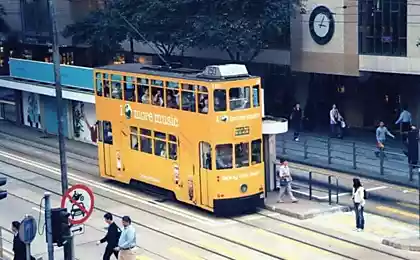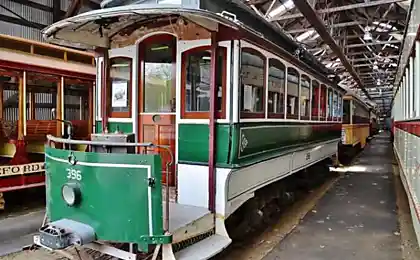1187
Trams LTZ.
I went out of the hospital and realized that quite a while not pleased with their transport YaPovtsev stories. It's time to mend!
Today I will tell you about the most unusual in my opinion trams of the former Soviet Union, on the application of technology in tramvaestroenii rail and car, ahead of his time by nearly fifteen years.
Trams production Luganskteplovoz. LT-10, LT-5, LT-10A.
29 photo source.

The project is the first car type LT10 was developed in 1991-1992. Construction of carriages was charged Luhansk ON "locomotive" of what happened and the name of the new car. The car was built with the use of rail technology, and got very mixed reviews. The first prototype LT10 hit the road in 1993
After most of the test program and Reaches a hundred kilometers to the designated 5,000 km, the car got into an accident. On that day, on a slope tram got out of control, it has developed a high speed, derailed in the curve and turned over on its side, drove tens of meters on the ground, almost falling into the nearby river. As it turned out, the accident was caused by the negligence test, disconnect the car on three of the four rail brakes. Reputation Luhansk trams was noticeably tainted ...

Next car, 002, was released in 1993. The date of his writing-off is unknown. The car did not have a passenger compartment, instead, has been equipped with all kinds of instruments and sensors. Similarly, he never worked on the routes and the car 003.
These cars tested and tuned management system and conducted all sorts of tests.
The body of the car has five doors: two double-leaf in the center of the body, the two single-- front and back, a single-wing front for the driver. Chassis was created taking into account the long-term experience to build locomotives - the trolley car had external boxes, gears, brakes, similar to those for locomotive 2TE116. The car was equipped with thyristor-width control system, a regeneratively-dynamic braking. All electrical equipment to facilitate access for the repair was made to the roof of the car. In addition, the car was one and a half meters longer than the other trams in its class - with a length of 16.5 meters.

In all there were more than 20 cars. Some of them (serial numbers 1, 2, 3) on the routes have not worked, because created for testing. Part (serial numbers 16, 17, 18 and 20+) were abandoned at the factory and never went.
(In the photo: the abandoned car bodies of cars LT-10 at the plant)

Outside the tram, to put it mildly, a non-classical. However, everything has its explanation - for example, the shape of a head-designed to improve the view of the driver in the landing area, in order to better control appropriate to the car people. Thus, a blind zone in the vicinity of the right front corner, typical for absolutely everyone, even the modern trams, this car simply absent.
Photo: running the new car in Moscow, 1999

Moscow LT-10 was the last wagon released this model (end 1998g.v.). From 1999 to 2002 he worked in the wagon route 17, between 2002 and 2003 - 14

The appearance of the car really well, very nonclassical agree

Unfortunately, the summer of 2003, the car was retired from operation and still waiting for the transfer to the museum Mosgortrans

Progressive, but unreliable management system (thyristor-pulse, production Zaporozhye) often fail. Combined with the absence of any support from the manufacturer and the persistent problems with spare parts is the decisive factor. The vast majority of cars have served for a few years and has become "immobilized»

Oh yeah, I forgot to show you the inside of wagons:
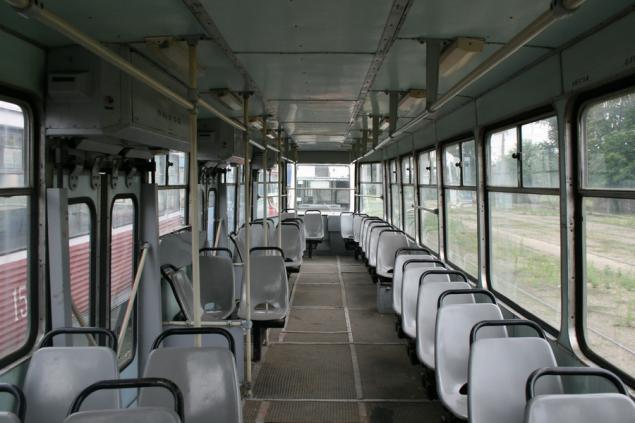
The trolley is more like a diesel than a tram, agree. According to eyewitnesses, the softness of the course at the car was unbelievable
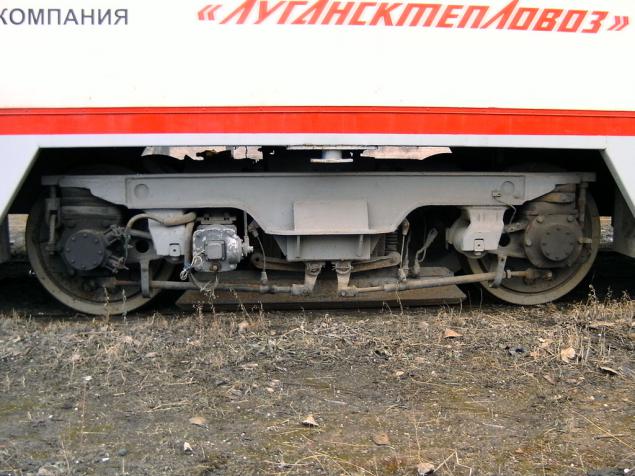
Yenakiyevo cars were dismissed from service in 1997 after only three years. For two years longer worked for the Moscow train - from 1998 to 2003. In Lugansk, cars pulling back an average of about five years. The longest in the passenger car operation lasted serial number 8 - in Lugansk, he worked under the hull number 203. This car has worked on the line for almost 11 years, from 1995 until 2006.
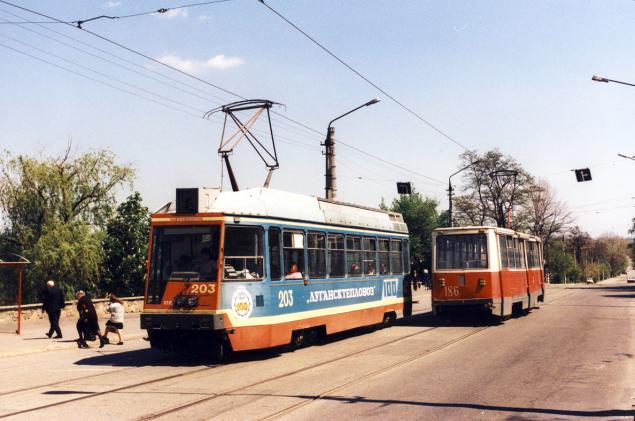
The spread of the car prevented and the high price. In 1995 the car was worth about 180 thousand. Dollars. United States, while the Ust-Katav 71-608, despite the need to deliver and significant technological backwardness, were much more favorable. Economy Ukraine has no significant financial and could not afford to buy the car, which was even better and unique, but expensive and unreliable. To this day it survived only two such cars: Moscow and one of the Lugansk (207 head. # 14); They are both in a state of slow-moving and most likely they will never take on passengers.

It is worth noting that in 1995 the company has been developed as polunizkopolny Wagon LT-10A. The tram was equipped with modern equipment, had pasted glazed cabin that allowed him to become the most modern at the time, and the first domestic polunizkopolnym carriage, almost 15 years ahead of Ust-Katav 71-623 (the first examples of which emerged in 2009, and mass production It was launched only in 2011). Unfortunately, the buyer was not found so far, and for almost 20 years, the car is worth at the plant

Shop LT10A - the first in the CIS polunizkopolnogo car
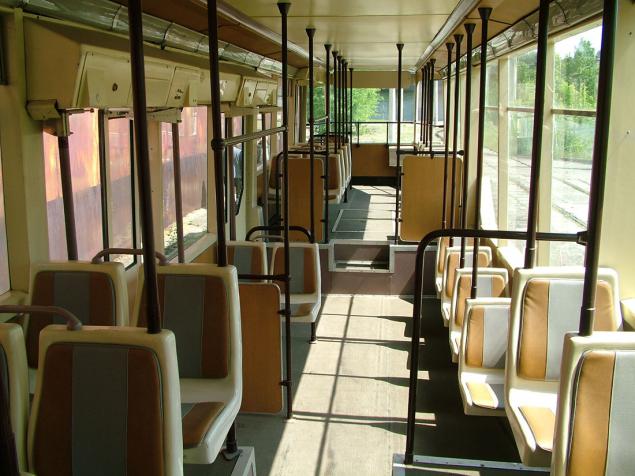
However, in 2003, he turned to Moscow for help Luganskteplovoz. Most of the time produced in the cars did not pass on the size of the shops in the old tram depot named Apakova. Then, especially for Moscow it was developed four cars LT-5. The Moscow side has put a condition: all the electric car to be produced in Russia at the Moscow factory "Dinamo". Lugansk machine builders wasted no time and developed from the ground up rather interesting car. The ends and the driver's cab were ordered in Poland, the factory Alstom - one of the world leaders tramvaestroeniya. Interior designed by Dnepropetrovsk MDC Design, who has previously worked with Luganskteplovoz to create a family of electric trains EPL. A huge experience in manufacturing mainline locomotives also found application in the LT-5. After a hard and rough carts KTMov Lugansk car, thanks to the axle-bearing suspension, striking softness stroke - there simply can not see the arrows travel!
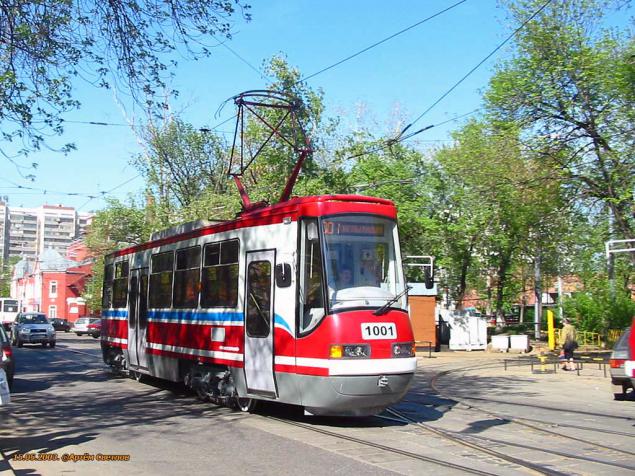
December 28th, 2002 the first LT-5 was presented to journalists and officials of Luhansk. During January were made and the remaining three cars. All of them have passed break-even posited in Lugansk. On February 19, the car rolled Ukrainian President Leonid Kuchma. In March, production tests were completed cars. Final price of the car was determined to be 795 000 hryvnia (4,475,850 Russian rubles, or about 135 thousand euros).
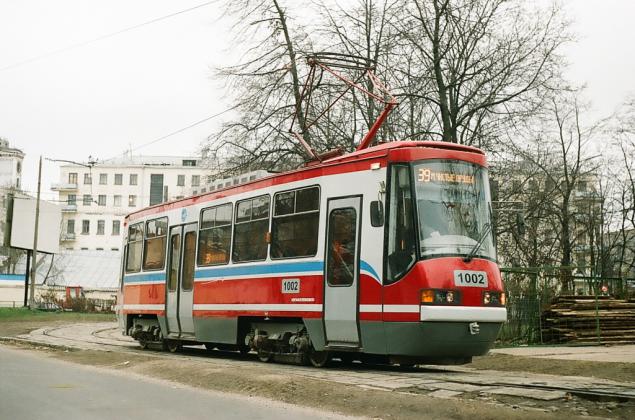
April 9, 2003, they arrived in Moscow at the station Ugreshskaya, 10, and 11 of them were taken to the depot. Apakova. By April 16 it reopened the first car, and during the acceptance procedure, he toured the depot before the authorities. April 19 at 15:40, he also makes probably the first independent check on the run-in for the depot - the day he reached Danilovskaya factory. After that the cars almost every day began to go on trial over the network Apakovskogo depot. We went mostly on lines 1, 14 and 26 routes. By May 15, the cars assigned park number 1001-1004.

Passenger carriages operation began June 1, 2003. The cars proved to be a good side, but for various reasons have been removed from the passenger operation by early 2006. However, the two cars LT-5 steel tugs, one transferred to the museum of urban transport. Another idle awaiting their fate. Unfortunately, the negotiations for the supply of another 20 cars were derailed, with it mainly because of political reasons.

Salon LT-5

More

Control

One of the carriages for his new job - to carry the defective cars on the territory of the repair plant
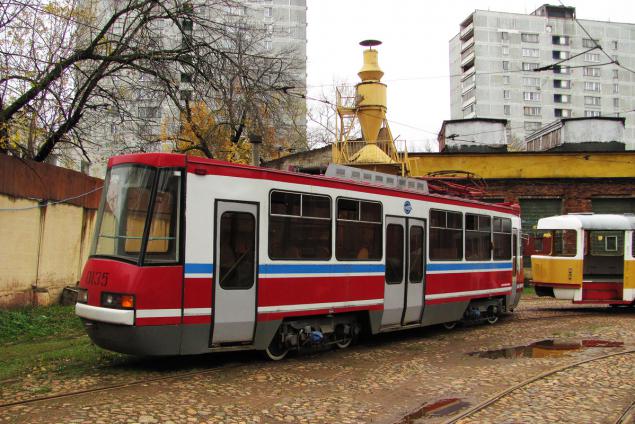
Another tug, this time from the depot Bauman
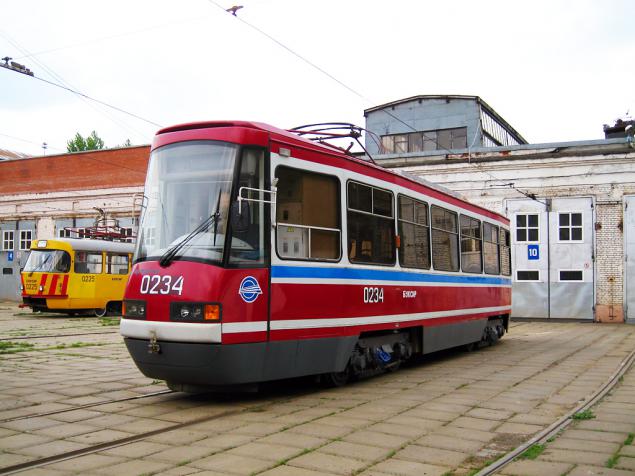
And this trailer waiting transfer to the museum

The last photo - a string of delayed operation of the RT-10 in Yenakiyevo ...

And cutting wagons metal Lugansk tram depot.
That such a fate was in these unique cars.
On this I have all, I hope someone was interested. Waiting for your comments on the bill exterior cabins :)

Source:
Today I will tell you about the most unusual in my opinion trams of the former Soviet Union, on the application of technology in tramvaestroenii rail and car, ahead of his time by nearly fifteen years.
Trams production Luganskteplovoz. LT-10, LT-5, LT-10A.
29 photo source.

The project is the first car type LT10 was developed in 1991-1992. Construction of carriages was charged Luhansk ON "locomotive" of what happened and the name of the new car. The car was built with the use of rail technology, and got very mixed reviews. The first prototype LT10 hit the road in 1993
After most of the test program and Reaches a hundred kilometers to the designated 5,000 km, the car got into an accident. On that day, on a slope tram got out of control, it has developed a high speed, derailed in the curve and turned over on its side, drove tens of meters on the ground, almost falling into the nearby river. As it turned out, the accident was caused by the negligence test, disconnect the car on three of the four rail brakes. Reputation Luhansk trams was noticeably tainted ...

Next car, 002, was released in 1993. The date of his writing-off is unknown. The car did not have a passenger compartment, instead, has been equipped with all kinds of instruments and sensors. Similarly, he never worked on the routes and the car 003.
These cars tested and tuned management system and conducted all sorts of tests.
The body of the car has five doors: two double-leaf in the center of the body, the two single-- front and back, a single-wing front for the driver. Chassis was created taking into account the long-term experience to build locomotives - the trolley car had external boxes, gears, brakes, similar to those for locomotive 2TE116. The car was equipped with thyristor-width control system, a regeneratively-dynamic braking. All electrical equipment to facilitate access for the repair was made to the roof of the car. In addition, the car was one and a half meters longer than the other trams in its class - with a length of 16.5 meters.

In all there were more than 20 cars. Some of them (serial numbers 1, 2, 3) on the routes have not worked, because created for testing. Part (serial numbers 16, 17, 18 and 20+) were abandoned at the factory and never went.
(In the photo: the abandoned car bodies of cars LT-10 at the plant)

Outside the tram, to put it mildly, a non-classical. However, everything has its explanation - for example, the shape of a head-designed to improve the view of the driver in the landing area, in order to better control appropriate to the car people. Thus, a blind zone in the vicinity of the right front corner, typical for absolutely everyone, even the modern trams, this car simply absent.
Photo: running the new car in Moscow, 1999

Moscow LT-10 was the last wagon released this model (end 1998g.v.). From 1999 to 2002 he worked in the wagon route 17, between 2002 and 2003 - 14

The appearance of the car really well, very nonclassical agree

Unfortunately, the summer of 2003, the car was retired from operation and still waiting for the transfer to the museum Mosgortrans

Progressive, but unreliable management system (thyristor-pulse, production Zaporozhye) often fail. Combined with the absence of any support from the manufacturer and the persistent problems with spare parts is the decisive factor. The vast majority of cars have served for a few years and has become "immobilized»

Oh yeah, I forgot to show you the inside of wagons:

The trolley is more like a diesel than a tram, agree. According to eyewitnesses, the softness of the course at the car was unbelievable

Yenakiyevo cars were dismissed from service in 1997 after only three years. For two years longer worked for the Moscow train - from 1998 to 2003. In Lugansk, cars pulling back an average of about five years. The longest in the passenger car operation lasted serial number 8 - in Lugansk, he worked under the hull number 203. This car has worked on the line for almost 11 years, from 1995 until 2006.

The spread of the car prevented and the high price. In 1995 the car was worth about 180 thousand. Dollars. United States, while the Ust-Katav 71-608, despite the need to deliver and significant technological backwardness, were much more favorable. Economy Ukraine has no significant financial and could not afford to buy the car, which was even better and unique, but expensive and unreliable. To this day it survived only two such cars: Moscow and one of the Lugansk (207 head. # 14); They are both in a state of slow-moving and most likely they will never take on passengers.

It is worth noting that in 1995 the company has been developed as polunizkopolny Wagon LT-10A. The tram was equipped with modern equipment, had pasted glazed cabin that allowed him to become the most modern at the time, and the first domestic polunizkopolnym carriage, almost 15 years ahead of Ust-Katav 71-623 (the first examples of which emerged in 2009, and mass production It was launched only in 2011). Unfortunately, the buyer was not found so far, and for almost 20 years, the car is worth at the plant

Shop LT10A - the first in the CIS polunizkopolnogo car

However, in 2003, he turned to Moscow for help Luganskteplovoz. Most of the time produced in the cars did not pass on the size of the shops in the old tram depot named Apakova. Then, especially for Moscow it was developed four cars LT-5. The Moscow side has put a condition: all the electric car to be produced in Russia at the Moscow factory "Dinamo". Lugansk machine builders wasted no time and developed from the ground up rather interesting car. The ends and the driver's cab were ordered in Poland, the factory Alstom - one of the world leaders tramvaestroeniya. Interior designed by Dnepropetrovsk MDC Design, who has previously worked with Luganskteplovoz to create a family of electric trains EPL. A huge experience in manufacturing mainline locomotives also found application in the LT-5. After a hard and rough carts KTMov Lugansk car, thanks to the axle-bearing suspension, striking softness stroke - there simply can not see the arrows travel!

December 28th, 2002 the first LT-5 was presented to journalists and officials of Luhansk. During January were made and the remaining three cars. All of them have passed break-even posited in Lugansk. On February 19, the car rolled Ukrainian President Leonid Kuchma. In March, production tests were completed cars. Final price of the car was determined to be 795 000 hryvnia (4,475,850 Russian rubles, or about 135 thousand euros).

April 9, 2003, they arrived in Moscow at the station Ugreshskaya, 10, and 11 of them were taken to the depot. Apakova. By April 16 it reopened the first car, and during the acceptance procedure, he toured the depot before the authorities. April 19 at 15:40, he also makes probably the first independent check on the run-in for the depot - the day he reached Danilovskaya factory. After that the cars almost every day began to go on trial over the network Apakovskogo depot. We went mostly on lines 1, 14 and 26 routes. By May 15, the cars assigned park number 1001-1004.

Passenger carriages operation began June 1, 2003. The cars proved to be a good side, but for various reasons have been removed from the passenger operation by early 2006. However, the two cars LT-5 steel tugs, one transferred to the museum of urban transport. Another idle awaiting their fate. Unfortunately, the negotiations for the supply of another 20 cars were derailed, with it mainly because of political reasons.

Salon LT-5

More

Control

One of the carriages for his new job - to carry the defective cars on the territory of the repair plant

Another tug, this time from the depot Bauman

And this trailer waiting transfer to the museum

The last photo - a string of delayed operation of the RT-10 in Yenakiyevo ...

And cutting wagons metal Lugansk tram depot.
That such a fate was in these unique cars.
On this I have all, I hope someone was interested. Waiting for your comments on the bill exterior cabins :)

Source:
